Launch Tech V1MDIAGUNIV LAUNCH V1M User Manual V1M DiagunIV
Launch Tech Co., Ltd. LAUNCH V1M V1M DiagunIV
15_V1M DiagunIV UserMan r1
V1M DiagunIV

LAUNCH English User Manual
i
Copyright Information
Copyright © 2017 by Launch Tech Co., Ltd. All rights reserved. No part of
this publication may be reproduced, stored in a retrieval system, or transmitted
in any form or by any means, electronic, mechanical, photocopying, recording or
otherwise, without the prior written permission of LAUNCH. The information
contained herein is designed only for the use of this unit. LAUNCH is not
responsible for any use of this information as applied to other units.
Neither LAUNCH nor its affiliates shall be liable to the purchaser of this unit or
third parties for damages, losses, costs, or expenses incurred by purchaser or
third parties as a result of: accident, misuse, or abuse of this unit, or
unauthorized modifications, repairs, or alterations to this unit, or failure to strictly
comply with LAUNCH operating and maintenance instructions. LAUNCH shall
not be liable for any damages or problems arising from the use of any options or
any consumable products other than those designated as Original LAUNCH
Products or LAUNCH Approved Products by LAUNCH.
Trademark Information
LAUNCH is a registered trademark of Launch Tech Co., Ltd. (also called
LAUNCH for short) in China and other countries. All other LAUNCH trademarks,
service marks, domain names, logos, and company names referred to in this
manual are either trademarks, registered trademarks, service marks, domain
names, logos, company names of or are otherwise the property of LAUNCH or
its affiliates. In countries where any of the LAUNCH trademarks, service marks,
domain names, logos and company names are not registered, LAUNCH claims
other rights associated with unregistered trademarks, service marks, domain
names, logos, and company names. Other products or company names referred
to in this manual may be trademarks of their respective owners. You may not
use any trademark, service mark, domain name, logo, or company name of
LAUNCH or any third party without permission from the owner of the applicable
trademark, service mark, domain name, logo, or company name. You may
contact LAUNCH by visiting the website at www.cnlaunch.com, or writing to
Launch Tech Co., Ltd. ˈLaunch Industrial Park, North of Wuhe Avenue,
Banxuegang, Bantian, Longgang, Shenzhen, Guangdong, P.R.China, to request
written permission to use Materials on this manual for purposes or for all other
questions relating to this manual.

LAUNCH English User Manual
ii
Important Safety Precautions
Important: To avoid personal injury, property damage, or accidental damage to
the product, read all of the information in this section before using the product.
y Never collide, throw, or puncture V1M, and avoid falling,
extruding and bending it.
y Do not insert foreign objects into or place heavy objects on your device.
Sensitive components inside might cause damage.
y Do not use V1M in exceptionally cold or hot, dusty, damp or dry
environments.
y In places using V1M may cause interference or generate a
potential risk, please turn it off.
y V1M is a sealed unit. There are no end-user serviceable parts
inside. All internal repairs must be done by an authorized repair facility or
qualified technician. If there is any inquiry, please contact the dealer.
y Never place V1M into apparatus with strong electromagnetic
field.
y Keep V1M far away from magnetic devices because its radiations
can damage the screen and erase the data stored on V1M.
y DANGER: Do not attempt to replace the internal rechargeable lithium battery.
Contact the dealer for factory replacement.
y CAUTION: Please use the included battery and charger. Risk of explosion if
the battery is replaced with an incorrect type.
y Do not disconnect power abruptly when V1M is being formatted
or in process of uploading or downloading. Or else it may result in program
error.
y Do not delete unknown files or change the name of files or directories that
were not created by you, otherwise your V1M software might fail
to work.
y Be aware that accessing network resources can leave your V1M
vulnerable to computer viruses, hackers, spyware, and other malicious
activities that might damage your device, software or data. It is your
responsibility to ensure that you have adequate protection in the forms of
firewalls, antivirus software, and anti-spyware software and keep such
software up to date.
Precautions on Using V1M
Before using this test equipment, please read the following safety information
carefully.
y Always perform automotive testing in a safe environment.

LAUNCH English User Manual
iii
y If the VCI connector remains unused for a long period of time, it is suggested
to unplug the connector from vehicle’s DLC to conserve battery power.
y Wear an ANSI-approved eye shield when testing or repairing vehicles.
y The vehicle shall be tested in a well ventilated work area, as engines produce
various poisonous compounds (hydrocarbon, carbon monoxide, nitrogen
oxides, etc.)
y Do not connect or disconnect any test equipment while the ignition is on or
the engine is running.
y Put blocks in front of the drive wheels and never leave the vehicle unattended
while testing.
y Keep the test equipment dry, clean, free from oil, water or grease. Use a mild
detergent on a clean cloth to clear the outside of the equipment as
necessary.
y Do not drive the vehicle and operate the test equipment at the same time.
Any distraction may cause an accident.
y Keep clothing, hair, hands, tools, test equipment, etc. away from all moving or
hot engine parts.
y Before starting the engine, put the gear lever in the Neutral position (for
manual transmission) or in the Park (for automatic transmission) position to
avoid injury.
y To avoid damaging the test equipment or generating false data, please make
sure the vehicle battery is fully charged and the connection to the vehicle
DLC (Data Link Connector) is clear and secure.
y Automotive batteries contain sulfuric acid that is harmful to skin. In operation,
direct contact with the automotive batteries should be avoided. Keep the
ignition sources away from the battery at all times.
Precautions on Operating Vehicle’s ECU
y Do not disconnect battery or any wiring cables in the vehicle when the ignition
switch is on, as this could avoid damage to the sensors or the ECU.
y Do not place any magnetic objects near the ECU. Disconnect the power
supply to the ECU before performing any welding operations on the vehicle.
y Use extreme caution when performing any operations near the ECU or
sensors. Ground yourself when you disassemble PROM, otherwise ECU and
sensors can be damaged by static electricity.
y When reconnecting the ECU harness connector, be sure it is attached firmly,
otherwise electronic elements, such as ICs inside the ECU, can be damaged.

LAUNCH English User Manual
iv
TABLE OF CONTENTS
1 INTRODUCTIONS .......................................................................................... 1
1.1 PRODUCT PROFILE ................................................................................. 1
1.2 FEATURES .............................................................................................. 1
1.3 KNOWLEDGE OF V 1M
.......................................................... 1
1.3.1 V1M whole
set ............................................................... 1
1.3.2 V1M handset
................................................................. 2
1.3.3 VCI connector (Only applies to 12V passenger cars) ...................... 3
1.4 TECHNICAL PARAMETERS ....................................................................... 4
1.5 PACKAGE LIST ........................................................................................ 5
2 PREPARATIONS ............................................................................................ 6
2.1 CHARGING V1M
..................................................................... 6
2.2 USING YOUR BATTERY ................................................................................ 6
2.3 POWER ON/OFF .......................................................................................... 6
2.3.1 Power on ........................................................................................... 6
2.3.2 Power off ........................................................................................... 6
2.4 TIPS ON FINGER OPERATIONS ..................................................................... 6
2.5 LOCK & UNLOCK THE SCREEN .................................................................... 7
2.5.1 Lock the screen ................................................................................ 7
2.5.2 Unlock the screen ............................................................................. 7
2.6 SCREEN LAYOUT ........................................................................................ 8
2.7 NOTIFICATION PANEL ................................................................................. 8
2.8 CUSTOMIZE YOUR DESKTOP ....................................................................... 8
2.8.1 Create a widget on the desktop ........................................................ 8
2.8.2 Move items on the desktop .............................................................. 8
2.8.3 Delete items from the desktop .......................................................... 8
2.8.4 Adjust brightness .............................................................................. 8
2.8.5 Set standby time ............................................................................... 9
2.9 SET SCREEN LOCK ..................................................................................... 9
3 WI-FI SETTING ............................................................................................. 10
3.1 CONNECT TO A WI-FI NETWORK ............................................................... 10

LAUNCH English User Manual
v
3.2 DISCONNECT FROM A WI-FI NETWORK ..................................................... 10
4 INITIAL USE & VEHICLE CONNECTION .................................................... 11
4.1 DIAGNOSIS FLOWCHART .......................................................................... 11
4.2 INITIAL USE .............................................................................................. 11
4.2.1 User registration ............................................................................. 11
4.2.2 Function menu ................................................................................ 14
4.3 CONNECTIONS ......................................................................................... 15
4.3.1 Preparation ..................................................................................... 15
4.3.2 DLC location ................................................................................... 15
4.3.3 Vehicle connection .......................................................................... 16
4.4 BLUETOOTH SETTING ............................................................................... 17
5 START DIAGNOSTICS ................................................................................. 18
5.1 HEALTH REPORT (QUICK TEST)................................................................ 18
5.1.1 View fault report .............................................................................. 19
5.1.2 Clear DTC ....................................................................................... 21
5.2 SYSTEM SCAN ......................................................................................... 22
5.3 SYSTEM SELECTION ................................................................................. 22
5.3.1 Version Information ......................................................................... 24
5.3.2 Read Fault Code ............................................................................ 24
5.3.3 Clear Fault Memory ........................................................................ 24
5.3.4 Read Data Stream .......................................................................... 25
6 RESET ........................................................................................................... 29
7 DIAGNOSIS FEEDBACK ............................................................................. 32
8 SOFTWARE UPDATE .................................................................................. 34
9 PERSONAL CENTER ................................................................................... 35
9.1 MY REPORT ............................................................................................. 35
9.2 MY CONNECTOR ...................................................................................... 35
9.3 ACTIVATE CONNECTOR ............................................................................ 35
9.4 FIRMWARE FIX ......................................................................................... 36
9.5 PROFILE .................................................................................................. 36
9.6 CHANGE PASSWORD ................................................................................ 36

LAUNCH English User Manual
vi
9.7 SETTINGS ................................................................................................ 37
9.7.1 Units of Measurement .................................................................... 37
9.7.2 About ............................................................................................... 37
9.7.3 Log out ............................................................................................ 37
10 OTHERS ..................................................................................................... 38
10.1 EMAIL .................................................................................................... 38
10.1.1 Configure an email account .......................................................... 38
10.1.2 Add an email account ................................................................... 38
10.2 BROWSER .............................................................................................. 38
10.2.1 Open browser ............................................................................... 38
10.2.2 Download files .............................................................................. 39
10.3 SYNCHRONIZATION ................................................................................ 39
10.3.1 Connect to PC .............................................................................. 39
10.3.2 Run on PC .................................................................................... 39
10.3.3 Install an application ..................................................................... 39
10.4 CLEAR CACHE ....................................................................................... 40
11 FAQ ............................................................................................................. 41

LAUNCH English User Manual
1
1 Introductions
1.1 Product Profile
V1M is an slim evolutionary vehicle diagnostic tool. Featuring a
quad-core 1.1GHz processor, and a 5.5 inch capacitive screen, V1M
delivers diagnostic functionality which helps to diagnose vehicle issues more
efficiently.
In addition, V1M supports Wi-Fi connection, one-click update,
diagnostic feedback and all kinds of service functions (including oil lamp reset
etc).
1.2 Features
1. Diagnostics:
A. Diagnose
Diagnose the electronic control systems of prevailing vehicle models
covering Asian, European, American and Chinese. Diagnosis functions
include: Read DTCs, Clear DTCs and Read data stream etc.
Specially designed for Android platform with clear and user-friendly
interface.
Via Bluetooth, it is simple for the VCI connector to communicate with V1M
B. Reset: Includes all kinds of maintenance resets.
C. One-click Update: lets you update diagnostic software and APK more
efficiently.
2. Browser: built-in Wi-Fi module makes surfing on the internet freely.
3. Email: allows you to send and receive emails.
4. Settings: to configure your personalized V1M through it.
5. Applications: other android based applications can be customized to install
or uninstall.
1.3 Knowledge of V1M
1.3.1 V1M whole set
There are two main components to the V1M system:
y V1M Handset -- the central system (for details, please refer to
Chapter 1.3.1.)

LAUNCH English User Manual
2
y VCI Connector -- the Vehicle Communication Interface for accessing vehicle
data
1.3.2 V1M handset
Fig. 1-1 V1M handset
1 Front camera
2 Slot for VCI connector For housing the VCI connector.
3 Speakers
4 Ambient light sensor
5 VOLUME +/- Key
To adjust the volume.
To print the screen, hold and press the
POWER and VOLUME – key until a
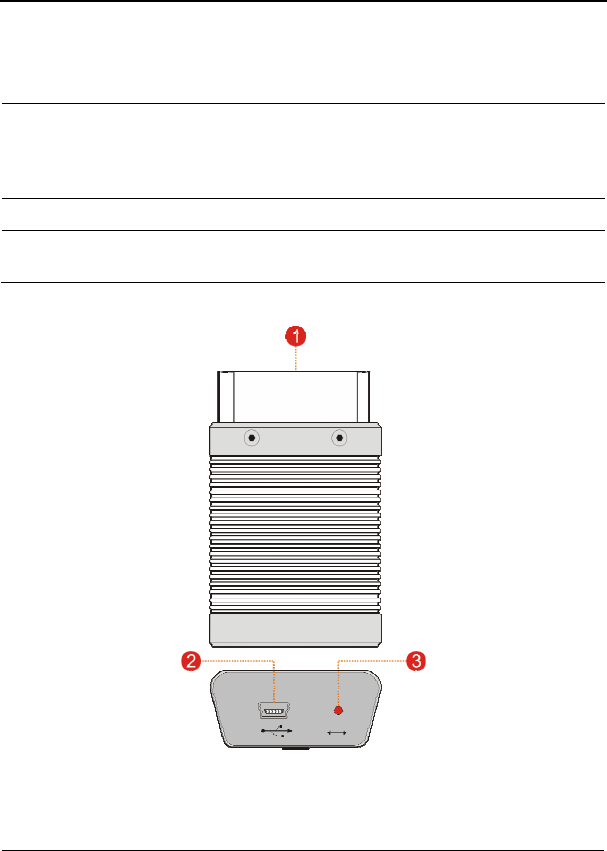
LAUNCH English User Manual
3
snapshot pops up on the screen. The
captured snapshot is saved in the
“Screenshots” folder.
6 POWER/Screen lock
key
In Off mode, press it to turn V1M
on;
In On mode, turn V1M off with
long press or lock screen with short press.
7 LCD screen
8 USB/Charging port To connect to the power adaptor for
charging the V1M handset.
1.3.3 VCI connector (Only applies to 12V passenger cars)
Fig. 1-2 VCI connector
1 OBD-16 diagnostic
connector To connect on vehicle’s OBD2 DLC.

LAUNCH English User Manual
4
2 Mini USB port
For connecting the USB cable to the tablet to
perform vehicle diagnosis. (Note: This port is
disabled for V1M.)
3 Mode indicator
y It illuminates red when the VCI connector is
connected to the vehicle’s DLC.
y Blue indicates the VCI connector is working
in Bluetooth mode.
1.4 Technical Parameters
V1M:
Operating system Android 7.0
Processor Quad core 1.1 GHz
Memory 1GB
Storage 16GB (Expandable up to 64GB)
LCD screen 5.5 inch IPS screen with a resolution of 1280 x 720
pixels
Camera Front-facing 2MP camera + rear-facing 8MP camera
Battery 2500mh rechargeable polymer lithium battery
Connectivity Wi-Fi: WLAN 802.11b/g/n
Bluetooth: Bluetooth 4.0
Working temperature 0 ~ ć45ć
Storage temperature -10 ~ ć50ć
VCI connector:
Working voltage 9 ~18V
Working temperature -10ć ~ 55ć
Storage temperature -20 ~ 70ć ć
Relative humidity 20% ~ 90%

LAUNCH English User Manual
5
1.5 Package List
While opening V1M package for the first time, please carefully check
the following components. Common accessories for each V1M are
same, but for different destinations, the accessories of V1M may
vary. Please consult from the local agency or check the package list supplied
with V1M together.
y V1M handset
y VCI connector (For connecting OBD II vehicles)
y Password envelope (A piece of paper bearing Product S/N and Activation
Code for product registration)
y OBD II extension cable (For connecting the VCI connector to OBD II
vehicle)
y OBD I adaptor (For connecting the non-16pin diagnostic connector and the
VCI connector)
y Power adaptor (For charging the V1M handset)
y Non-16pin connectors (For connecting non-OBD II vehicle)

LAUNCH English User Manual
6
2 Preparations
2.1 Charging V1M
1. Plug one end of the included power adaptor into the USB port of the V1M
2. Connect the other end to the AC outlet.
If appears on the screen, it indicates it is being charged. If the logo changes
into , it indicates that the battery is fully charged. Unplug the power adaptor
from V1M.
2.2 Using your battery
If the battery remains unused for a long period of time or the battery is
completely discharged, it is normal that the tool will not power on while being
charged. Please charge it for a period of 5 minutes and then turn it on.
Please use the included power adaptor to charge your tool. No responsibility
can be assumed for any damage or loss caused as a result of using power
adaptors other than the one supplied.
While V1M has low battery, a beep will sound. If it is very low, V1M
will be switched off automatically.
2.3 Power on/off
2.3.1 Power on
Press [POWER] to turn the tool on.
Note: If it is the first time you have used this tool or the tool remains idle for a long
period of time, the tool could fail to turn on. Please charge the tool for a minimum of 5
minutes and attempt to turn on again.
2.3.2 Power off
Press [POWER] for 3 seconds, an option menu will pop up on the screen. Tap
“Power off” to turn the tool off.
2.4 Tips on finger operations
Single-tap: To select an item or launch a program.
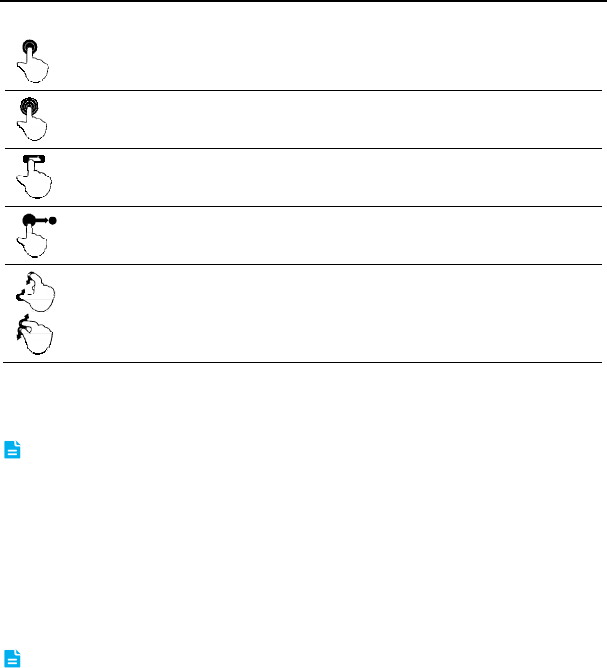
LAUNCH English User Manual
7
Double-tap: To zoom in so that the text on a webpage appears in a
column that fits your device’s screen.
Long press: Tap and hold on the current interface or area until a
contextual menu pops up on the screen, and then release it.
Slide: To jump to different pages.
Drag: Tap the application icon and drop it to other location.
Spread apart/pinch together: To zoom in manually, place two
fingers on the screen and then spread them apart. To zoom out,
place two fingers apart on the screen and then pinch them together.
2.5 Lock & unlock the screen
Many screen lock modes are available on V1M.
Note: You are recommended to set screen lock as “None” since V1M is
a frequently used diagnostic tool.
2.5.1 Lock the screen
When it is ON, press [POWER] once to lock the screen;
The system will lock the screen automatically after V1M remains
idle over the preset standby time.
2.5.2 Unlock the screen
Press [POWER] to activate the screen and drag the lock to “Unlock” position.
Note: If you define as unlock using the pattern, you have to draw the right target
pattern to unlock it.
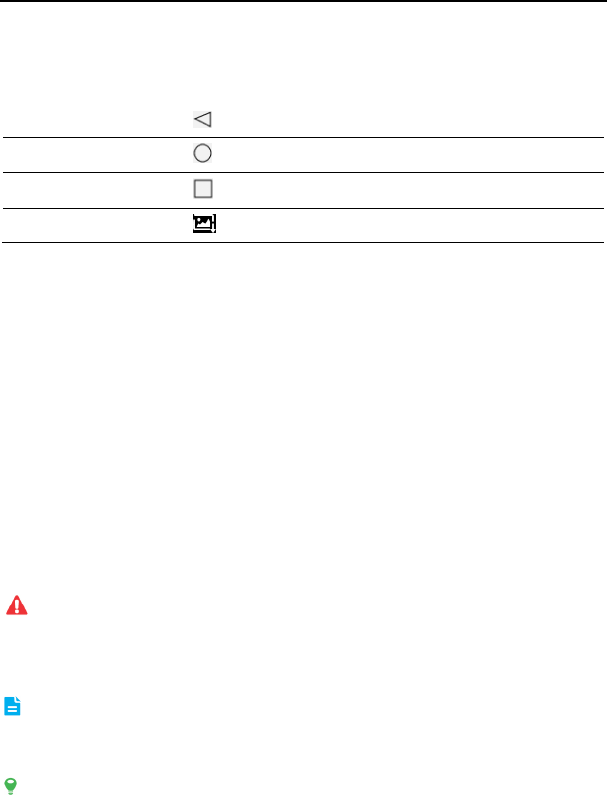
LAUNCH English User Manual
8
2.6 Screen layout
There are four on-screen buttons available on the bottom of the screen.
BACK Tap to return to the previous screen.
HOME Tap to navigate to the Android’s home screen.
Recent Apps Tap to view the recently launched applications.
Screenshot Tap to capture the current screen.
2.7 Notification panel
The notification bar is used to display some activities, such as new message, to
do list and running tasks. You can also open the notification bar to view the
reminder or activity notification.
2.8 Customize your desktop
2.8.1 Create a widget on the desktop
Tap and hold the desired application or widget, and then drag it to the target
position.
2.8.2 Move items on the desktop
Tap and hold the item to be moved, and drag and drop it to the target location.
2.8.3 Delete items from the desktop
Warning: Deleting an icon will uninstall the corresponding application. Please be
careful to do so.
1. Tap and hold the item to be moved until it is shaken.
2. Drag it on the trash icon and release it.
Note: If no trash icon appears on the top of the screen, it indicates that the
application cannot be uninstalled.
2.8.4 Adjust brightness
Tips: Reducing the brightness of the screen is helpful to save the power of
V1M.
1. On the home screen, tap Settings > Display > Brightness level.
2. Drag the slider to adjust it.

LAUNCH English User Manual
9
2.8.5 Set standby time
If no activities are made within the defined standby period, the screen will be
locked automatically and the system enters sleep mode to save power.
1. On the home screen, tap Settings > Display > Sleep.
2. Choose the desired sleep time.
2.9 Set screen lock
This function is designed to lock the screen and buttons to avoid accidental
operations while V1M keeps unused.
1. On the home screen, tap Settings > Security > Screen lock.
2. Choose the desired screen lock mode and follow the on-screen instructions to
finish your setting.
Note: You are recommended to set screen lock as “None” since V1M is
a frequently used diagnostic tool.

LAUNCH English User Manual
10
3 Wi-Fi Setting
Note: If you don’t need to use Wi-Fi for a while, you can turn it off to conserve
battery life.
XV1M has built-in Wi-Fi that can be used to get online. Once you’re
online, you can register your V1M, surf the Internet, get apps, send
email, launch the remote diagnosis, and check for software updates etc.
3.1 Connect to a Wi-Fi network
1. On the home screen, tap Settings -> WLAN.
2. Slide the Wi-Fi switch to ON, V1M will start searching for
available wireless networks.
3. Select a wireless network,
y If the chosen network is open, V1M will connect
automatically;
y If the selected network is encrypted, a network password will need to be
entered.
4. When “Connected” appears, it indicates the Wi-Fi connection is complete.
Note: When Wi-Fi is not required, this should be disabled to conserve battery
power.
Once it is connected successfully, tap the Wi-Fi network from the list to view its
name, link speed, security type, IP address etc.
When this tool is in range, it will connect to the previously linked network
automatically.
3.2 Disconnect from a Wi-Fi network
1. On the home screen, tap Settings -> WLAN.
2. Tap the network with a Connected status, then tap “Disconnect”.
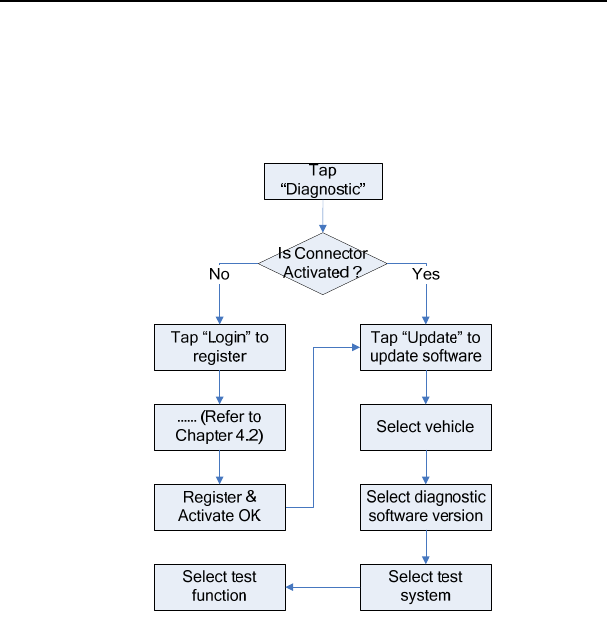
LAUNCH English User Manual
11
4 Initial Use & Vehicle Connection
4.1 Diagnosis Flowchart
For new users, please follow the operation chart shown in Fig. 4-1 to get familiar
with and start using V1M
Fig. 4-1
4.2 Initial Use
During initial use, tap the V1M icon on the home screen to launch it
and enter the main menu screen.
By default, all software is pre-installed on the V1M and can be used
to diagnose vehicles even if you do not experience the product registration. To
enable you to get one-click update and enjoy more functions and better service,
you are recommended to make app sign-up and product activation for the first
time.
4.2.1 User registration
Tap “Login” on the upper right corner of the main menu screen:

LAUNCH English User Manual
12
Fig. 4-2
1. If you are a new user, tap “New Registration”. See Fig. 4-3.
Fig. 4-3
Note: To obtain better service, you need to provide real information.
A. Create App account: In Fig. 4-3, fill in the information in each field and then
tap “Register”, a screen similar to the following will appear:

LAUNCH English User Manual
13
Fig. 4-4
B. Activate the VCI connector: In Fig. 4-4, input the Serial Number and
Activation Code, which can be found in the password envelope.
Fig. 4-5
Note: To exit and activate it later, tap “Skip”. In this case, you can activate your
connector by tapping “Activate Connector” in “Personal Center”. For details, please
refer to Chapter 9.3 Activate Connector.
C. Download diagnostic software: Tap “Activate”, a dialog box similar to Fig. 4-6
will appear:
Fig. 4-6
Product SN
Activation code
Product SN
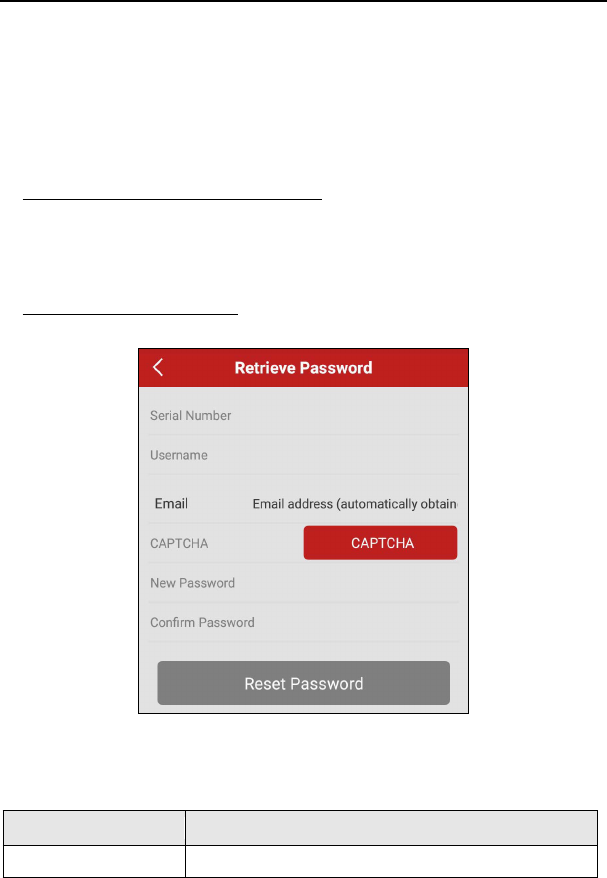
LAUNCH English User Manual
14
To download the diagnostic software, tap “Yes” to enter the software download
page. Tap “No” to download it later.
On the download page, tap “Update” to start downloading. It may take several
minutes to finish it, please be patient to wait. To pause downloading, tap “Pause”.
To resume it, tap “Continue”.
Once download is complete, the system will install the software package
automatically.
2. If you have registered to be a member, input your name and password, and
then tap the “Login” button to enter the main menu screen directly.
Note: V1M has an auto-save function. Once the username and password are
correctly entered, the system will automatically store it. Next time you login the system,
you will not be asked to input the account manually.
3. If you forgot the password, tap “Retrieve Password”, and then follow the
on-screen instructions to retrieve it.
Fig. 4-7
4.2.2 Function menu
It mainly includes the following items:
Name Description
Diagnose Configures V1M to operate as a

LAUNCH English User Manual
15
diagnostic tool.
Special Function
To perform some maintenance items, including
electronic throttle position reset, ABS bleeding, oil
lamp reset etc.
Feedback Diagnosis
This option allows you to feed back the diagnostic
reports/software bugs to us for troubleshooting and
analysis.
Software Upgrade
To update vehicle diagnostic software. If you keep
signed in, a pop-up message will appear on the
screen once a newer version is detected.
Maintenance Help To browse the FAQ, Quick Start Guide, User Manual
and How-To videos.
Personal Center To manage, activate your VCI connector, diagnostic
report or personal information etc.
4.3 Connections
4.3.1 Preparation
Normal testing conditions
y Turn on the vehicle power supply.
y Vehicle battery voltage range should be 9-14 Volts.
y Throttle should be in a closed position.
Select the VCI connector
If V1M is testing vehicles equipped with universal OBD II diagnostic
socket, please use the included VCI connector. (For vehicles with non-OBD II
diagnostic socket, a non-16 pin connector is required.)
4.3.2 DLC location
The DLC (Data Link Connector) is typically a standard 16-pin connector where
diagnostic tools interface with a vehicle’s on-board control modules. The DLC is
usually located 12 inches from the center of the instrument panel, under or
around the driver’s side for most vehicles. See Fig. 4-7 for DLC location of
different vehicles. If DLC is not located under dashboard, a label should be there
telling location. For some Asian and European vehicles, the DLC is located
behind the ashtray and the ashtray must be removed to access the connector. If
the DLC cannot be found, refer to the vehicle’s service manual.

LAUNCH English User Manual
16
Fig. 4-8
4.3.3 Vehicle connection
The method used to connect the VCI connector to a vehicle’s DLC depends on
the vehicle’s configuration as follows:
y A vehicle equipped with an OBD II management system supplies both
communication and 12V power through a standardized DLC.
y A vehicle not equipped with an OBD II management system supplies
communication through a DLC connection, and in some cases supplies 12V
power through the cigarette lighter receptacle or a connection to the vehicle
battery.
Follow the steps mentioned below to connect OBD II vehicle:
1. Locate vehicle’s DLC socket.
2. Plug the VCI connector into the vehicle’s DLC socket (It is suggested to use
the OBD II extension cable to connect the VCI connector and DLC socket).
3. Choose one of the two ways to obtain power from:
A. Power adaptor: Connect one end of the included power adaptor to DC IN
port of V1M handset, and the other end to AC outlet.
B. Internal battery pack
For non-OBDII vehicle, proceed as follows:
1. Locate vehicle’s DLC socket.
2. Select the corresponding non-16pin connector.
3. Plug the non-16pin end of the connector into the DLC socket, then connect
the other end to the OBD I adaptor, and then tighten the captive screws.
4. Connect the other end of the adaptor to the included VCI connector.
5. To supply power to OBD I adaptor from:
A. Cigarette Lighter cable(optional): Connect one end of the cigarette lighter
cable to vehicle’s cigarette lighter receptacle, and the other end to the power
jack of OBD I adaptor.
B. Battery Clamps Cable(optional): Connect one end of the battery clamps

LAUNCH English User Manual
17
cable to vehicle’s battery, and the other end to the power jack of OBD I
adaptor.
4.4 Bluetooth Setting
Enter V1M Bluetooth setting screen (“Settings” -> “Bluetooth”), slide
the Bluetooth switch to ON and V1M will start searching available
Bluetooth device, tap the desired connector to pair.
By default, the Bluetooth name is 98729*****00 (where ***** stands for 5 digits.).
Note: In case no Bluetooth setting is done before diagnostic software is launched,
you can also configure it while using the software. For details on Bluetooth connection,
please refer to Chapter 4.5 “Start diagnosing”.
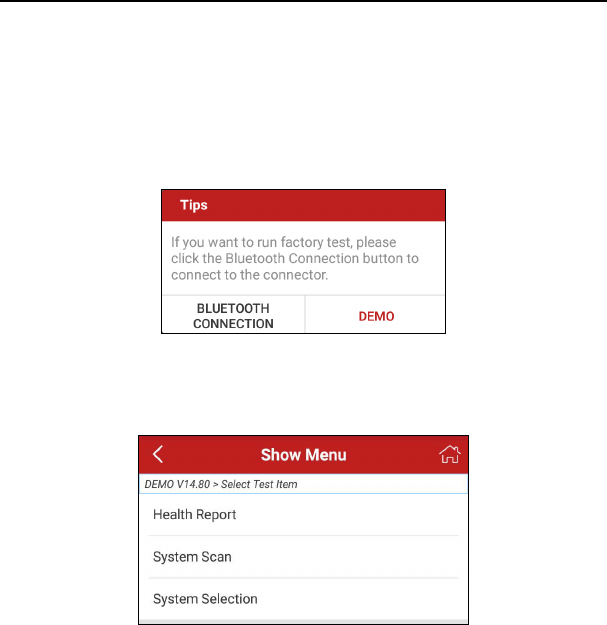
LAUNCH English User Manual
18
5 Start Diagnostics
Follow the steps mentioned below to start a new diagnostic session.
Tap “Diagnostic”, and then tap a corresponding diagnostic software logo.
Take Demo as an example to demonstrate how to diagnose a vehicle.
1). Tap the “DEMO”, a screen similar to the following appears:
Fig. 5-1
2). Tap “Demo” to ignore Bluetooth connection and jump to the test item
selection screen. (Note: No Bluetooth connection is required for DEMO
program.)
Fig. 5-2
5.1 Health Report (Quick Test)
This function varies from vehicle to vehicle. It enables you to quickly access all
the electronic control units of the vehicle and generate a detailed report about
vehicle health.
Tap “Health Report”, the system start scanning the ECUs. Once the scanning is
complete, a screen similar to the following appears:

LAUNCH English User Manual
19
Fig. 5-3
In Fig. 5-3, the tested system with fault code appears in red and the system with
OK displays in black (normally).
Tap the desired system to enter the test function selection page. For detailed
operations on test function, please refer to Chapter 5.3.
On-screen Buttons:
Clear DTC: Tap to clear the existing diagnostic trouble codes. See Chapter
5.1.2.
Fault Report: Tap to view the health report in details. See Chapter 5.1.1.
5.1.1 View fault report
This function allows you to view the health report in details.
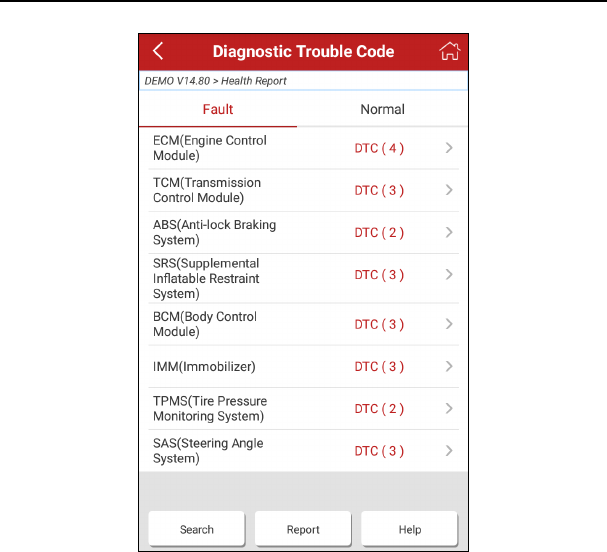
LAUNCH English User Manual
20
Fig. 5-4
In Fig. 5-4:
The systems that have been found OK are shown in black under the Normal tab.
The tested systems with faults are listed under the Fault tab and the number of
DTC is displayed in red next to the system. Tap > to view the detailed DTC
information of the current system.
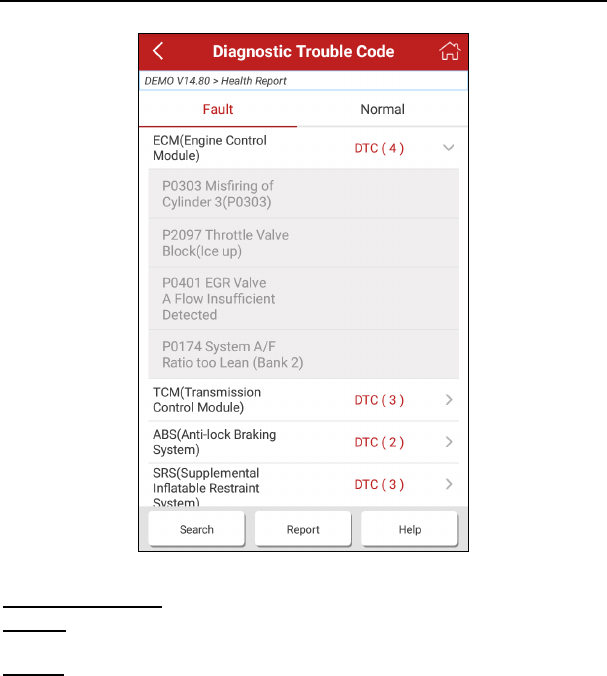
LAUNCH English User Manual
21
Fig. 5-5
On-screen Buttons:
Search: Highlight a certain DTC item, and then tap it to launch the browser to
search for more detailed information about the selected DTC online.
Report: To save the current data in text format. All reports are saved under the tab
“Report” in “My Report” from “Personal Center” menu. For details on report
operations, please refer to Chapter 9.1 “My Report”.
5.1.2 Clear DTC
This function lets you clear the existing diagnostic trouble codes in health report.
Tap “Clear DTC”, a confirmation dialog box appears. Tap “Yes” to clear all the
diagnostic trouble codes. Tap “No” to abort it.
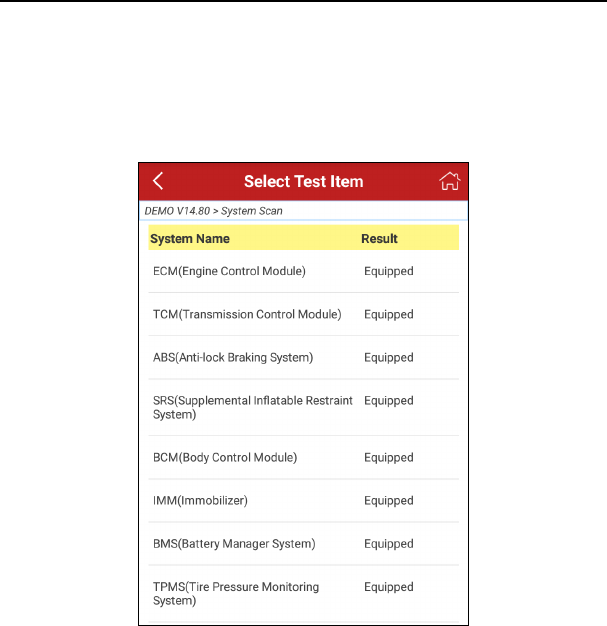
LAUNCH English User Manual
22
5.2 System Scan
This option allows you to quickly scan which systems are installed on the
vehicle.
In Fig. 5-2, tap “System Scan”, the system start scanning the systems. Once the
scanning is complete, the screen will display the result. See Fig. 5-6.
Fig. 5-6
In Fig. 5-3, tap the desired system to advance to the test function selection page.
For detailed operations on test function, please refer to Chapter 5.3.
5.3 System Selection
This option allows you manually select the test system and function step by step.
In Fig. 5-2, tap “System Selection”, the screen displays as follows:
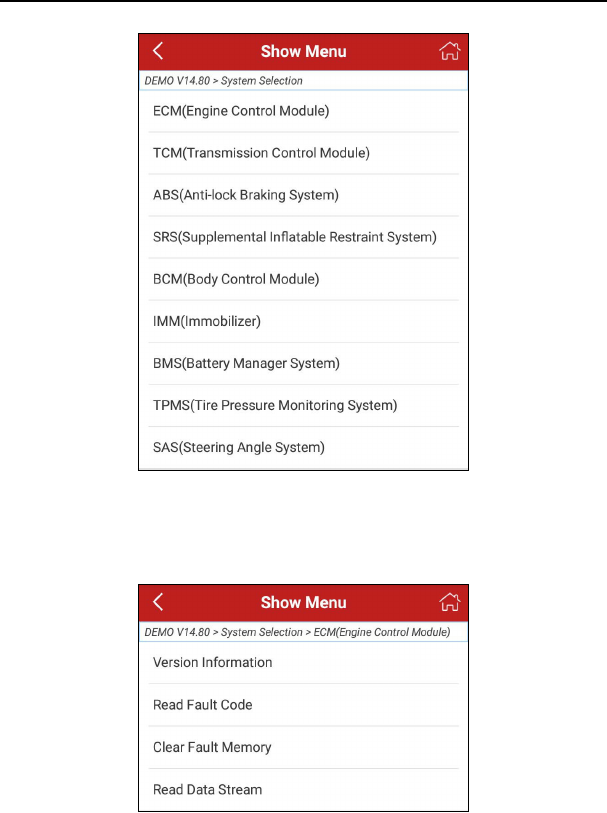
LAUNCH English User Manual
23
Fig. 5-7
Swipe the screen from the bottom to view the vehicle system on the next page.
Tap the desired system (take “ECM” for example) to jump to the test function
page.
Fig. 5-8
Note: Different vehicle has different diagnostic menus.
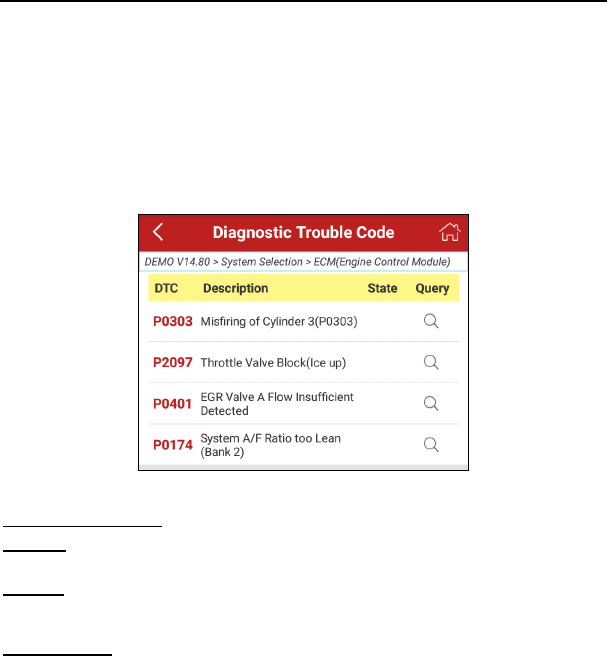
LAUNCH English User Manual
24
5.3.1 Version Information
This function is used to read the version information of system mode, vehicle
VIN, software and ECU.
5.3.2 Read Fault Code
This function displays the detailed information of DTC records retrieved from the
vehicle’s control system.
In Fig. 5-8, tap “Read DTC”, the screen will display the diagnostic result.
Fig. 5-9
On-screen Buttons:
Search: Highlight a certain DTC item, and then tap it to search for more
information about the selected DTC online.
Report: To save the current data in text format. All reports are saved under the tab
“Diagnostic Report” in “My Report” from “Personal Center” menu. For details on
report operations, please refer to Chapter 9.1 “My Report”.
Freeze Frame: When an emission-related fault occurs, certain vehicle conditions are
recorded by the on-board computer. This information is referred to as freeze frame
data. Freeze frame data includes a snapshot of critical parameter values at the
time the DTC is set.
5.3.3 Clear Fault Memory
After reading the retrieved codes from the vehicle and certain repairs have been
carried out, you can use this function to erase the codes from the vehicle. Before
performing this function, please be sure the vehicle’s ignition key is in the ON
position with the engine off.
In Fig. 5-8, tap “Clear Fault Memory”, a confirmation dialog box pops up on the
screen. Tap “Yes”, the system will automatically delete the currently existing
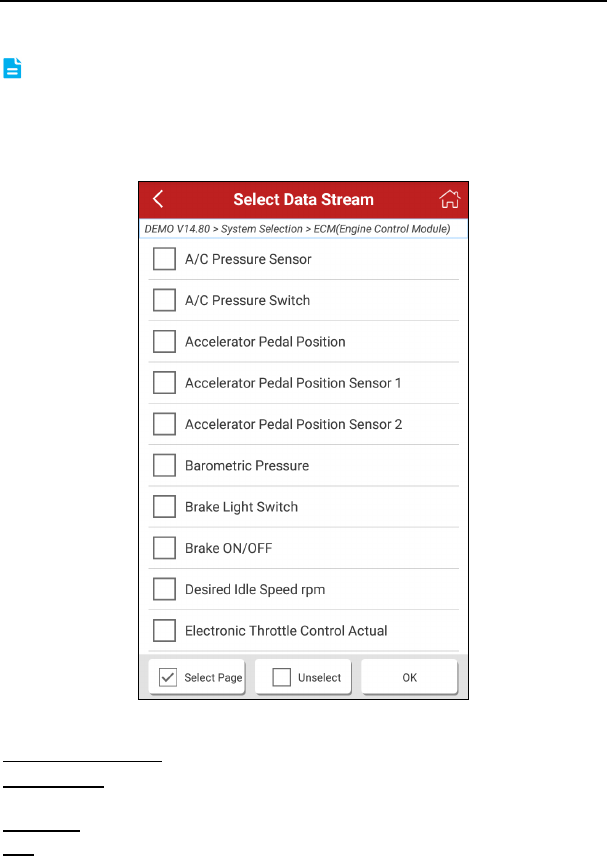
LAUNCH English User Manual
25
trouble code.
Note: The trouble code will not disappear until the trouble was completely cleared.
5.3.4 Read Data Stream
This option retrieves and displays live data and parameters from the vehicle’s ECU.
In Fig. 5-8, tap “Read Data Stream”, the system will display data stream items.
Fig. 5-10
On-screen Buttons:
Select Page: Tap it to select all items of the current page. To select certain data
stream item, just check the box before the item name.
Unselect: Tap it to deselect all data stream items.
OK: Tap it to confirm and jump to the next step.
After selecting the desired items, tap “Confirm” to enter the data stream reading

LAUNCH English User Manual
26
page.
Fig. 5-11
Notes:
1. If the value of the data stream item is out of the range of the standard (reference)
value, the whole line will display in red. If it complies with the reference value, it
displays in black (normal mode).
2. The indicator 1/X shown on the bottom of the screen stands for the current
page/total page number. Swipe the screen from the right/left to advance/return to the
next/previous page.
On-screen Buttons:
Record: Tap to start recording diagnostic data for future playback and analysis.
The saved file follows the naming rule: It begins with vehicle type, and then the
record starting time and ends with .x431 (To differentiate between files, please
configure the accurate system time). The file is stored in “My Report” under

LAUNCH English User Manual
27
“Personal Center” menu. For details on playback operations, please refer to
Chapter 9.1 “My Report”.
To stop reading the data stream, tap before the recording progress bar.
Saved data: Tap to access to “My Reports”.
Report: Tap to save the current waveform as a diagnostic record.
There are 3 types of display modes available for data viewing, allowing you to
view various types of parameters in the most suitable way.
9 Value – this is the default mode which displays the parameters in texts and
shows in list format.
The following display modes are under Graph tab.
9 Graph – displays the parameters in waveform graphs. Refer to Fig. 5-12.
Fig. 5-12
9 Combine – this option is mostly used in graph merge status for data
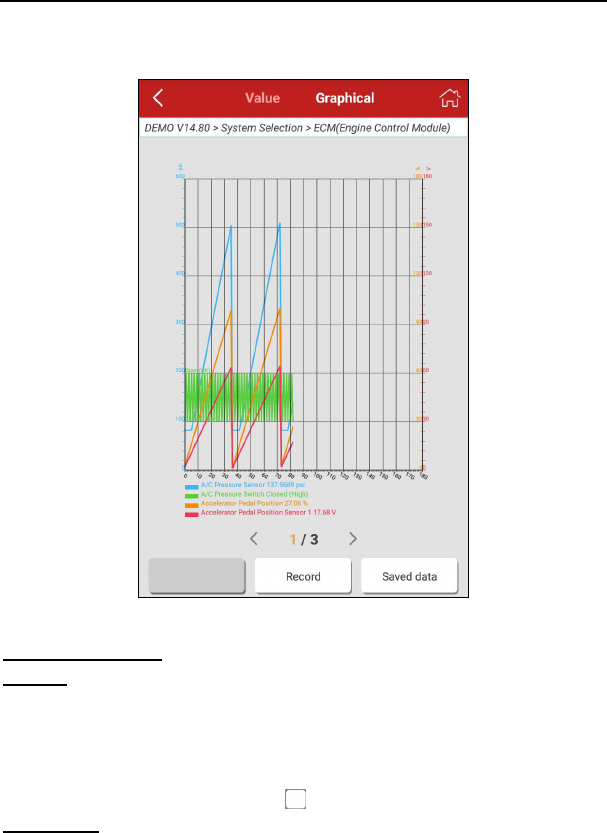
LAUNCH English User Manual
28
comparison. In this case, different items are marked in different colors. See
Fig. 5-13.
Fig. 5-13
On-screen Buttons:
Record: Tap to start recording diagnostic data for future playback and analysis.
The saved file follows the naming rule: It begins with vehicle type, and then the
record starting time and ends with .x431 (To differentiate between files, please
configure the accurate system time). The file is stored in “My Report” under
“Personal Center” menu. For details on playback operations, please refer to
Chapter 9.1 “My Report”.
To stop reading the data stream, tap before the recording progress bar.
Saved data: Tap to access to “My reports”.

LAUNCH English User Manual
29
6 Reset
The Reset section is specially designed to provide you quick access to the
vehicle systems for various scheduled service and maintenance performances.
All resetting operations are driven by executive commands. Just by following the
on-screen prompts to select appropriate execution options, input correct values
or data, and perform necessary actions, the system will guide you through the
complete performance.
The most commonly performed service functions contain:
y Oil Reset Service
y Steering Angle Calibration
y Electronic Parking Brake Reset
y Battery Register / Battery Maintenance
y ABS Bleeding
y Electronic Throttle Position Reset / Learn
y Diesel Particulate Filter (DPF) Regeneration
y Tire Pressure Monitor System Reset
Oil Reset Service
This function can be performed in the following cases:
1. If the service lamp is on, you must provide service for the car. After service,
you need to reset the driving mileage or driving time so that the service lamp
turns off and the system enables the new service cycle.
2. After changing engine oil or electric appliances that monitor oil life, you need
to reset the service lamp.
Steering Angle Calibration
1. To reset the steering angle, first find the relative zero point position for the car
to drive in straight line. Taking this position as reference, the ECU can
calculate the accurate angle for left and right steering.
2. After replacing the steering angle position sensor, replacing steering
mechanical parts (such as steering gearbox, steering column, end tie rod,
steering knuckle), performing four-wheel alignment, or recovering car body,
you must reset the steering angle.
Electronic Parking Brake Reset

LAUNCH English User Manual
30
1. If the brake pad wears the brake pad sense line, the brake pad sense line
sends a signal sense line to the on-board computer to replace the brake pad.
After replacing the brake pad, you must reset the brake pad. Otherwise, the
car alarms.
2. Reset must be performed in the following cases:
a) The brake pad and brake pad wear sensor are replaced.
b) The brake pad indicator lamp is on.
c) The brake pad sensor circuit is short, which is recovered.
d) The servo motor is replaced.
Electronic Throttle Position Reset/Learn
This function enables you to initialize the throttle actuators so that the “learned”
values stored on ECU are returned to the default state. Doing so can accurately
regulate throttle (or idle engine) operations to control the amount of air intake.
Throttle matching must be performed in the following cases:
a) The ECU is replaced and the ECU does not yet store throttle working
features.
b) The ECU is disconnected from power and the ECU memory is lost.
c) The throttle assembly is replaced.
d) The intake pipe is replaced or removed, which affects idle speed control by
ECU and throttle body.
e) The throttle is cleaned. Although the idle throttle potentiometer features
remain unchanged, with the same throttle opening, the air inflow has
changed and idle speed control features have changed.
Battery Register/Battery Maintenance
This function enables you to perform a resetting operation on the monitoring unit
of vehicle battery, in which the original low battery fault information will be
cleared and battery matching will be done.
Battery matching must be performed in the following cases:
a) Main battery is replaced. Battery matching must be performed to clear
original low battery information and prevent the related control module from
detecting false information. If the related control module detects false
information, it will invalidate some electric auxiliary functions, such as
automatic start & stop function, sunroof without one-key trigger function,
power window without automatic function.
b) Battery monitoring sensor. Battery matching is performed to re-match the
control module and motoring sensor to detect battery power usage more

LAUNCH English User Manual
31
accurately, which can avoid an error message displaying on the instrument
panel.
ABS Bleeding
This function allows you to perform various bi-directional tests to check the
operating conditions of Anti-lock Braking System (ABS).
1. When the ABS contains air, the ABS bleeding function must be performed to
bleed the brake system to restore ABS brake sensitivity.
2. If the ABS computer, ABS pump, brake master cylinder, brake cylinder, brake
line, or brake fluid is replaced, the ABS bleeding function must be performed
to bleed the ABS.
Tire Pressure Monitor System Reset
1. After the tire pressure MIL turns on and maintenance is performed, the tire
pressure resetting function must be performed to reset tire pressure and turn
off the tire pressure MIL.
2. Tire pressure resetting must be performed after maintenance is performed in
the following cases: tire pressure is too low, tire leaks, tire pressure
monitoring device is replaced or installed, tire is replaced, tire pressure sensor
is damaged, and tire is replaced for the car with tire pressure monitoring
function.
Diesel Particulate Filter (DPF) Regeneration
DPF regeneration is used to clear PM (Particulate Matter) from the DPF filter
through continuous combustion oxidation mode (such as high temperature
heating combustion, fuel additive or catalyst reduce PM ignition combustion) to
stabilize the filter performance.
DPF regeneration may be performed in the following cases:
a) The exhaust back pressure sensor is replaced.
b) The PM trap is removed or replaced.
c) The fuel additive nozzle is removed or replaced.
d) The catalytic oxidizer is removed or replaced.
e) The DPF regeneration MIL is on and maintenance is performed.
f) The DPF regeneration control module is replaced.
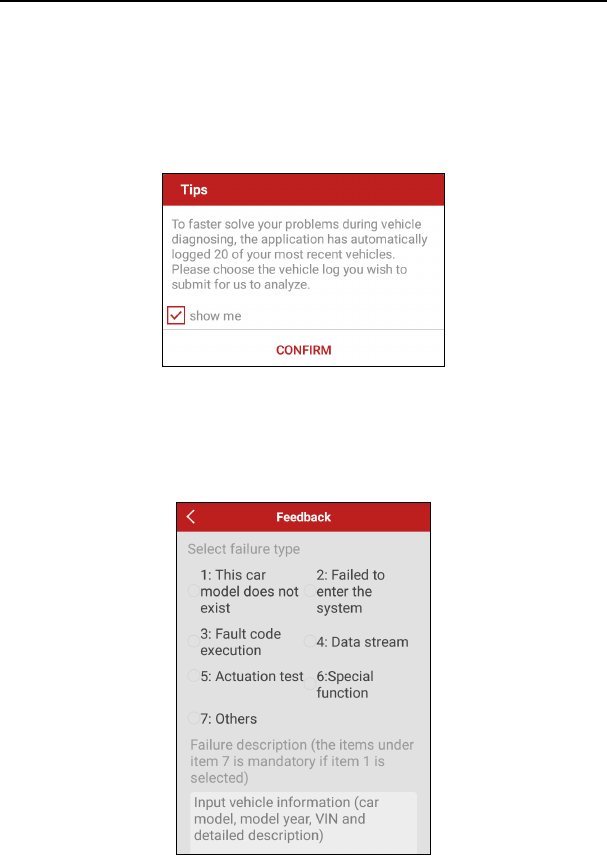
LAUNCH English User Manual
32
7 Diagnosis Feedback
This item allows you to feedback your diagnostic problems to us for analysis and
troubleshooting.
Tap “Diagnostic Feedback”, a pop-up message will appear:
Fig. 7-1
Tap “CONFIRM” to choose the vehicle diagnostic record page.
A). Tap the desired vehicle to enter the diagnostic log selection page.
Select the check box and tap “Submit”. A screen similar to the following will
appear:
Fig. 7-2

LAUNCH English User Manual
33
Check the box before the failure type, fill in the detailed failure description in the
blank text box and telephone or email address. After inputting, tap “Submit
Result” to send it to us.
B). Tap “History”, the diagnostic logs marked with different color indicate the
process status of the diagnostic feedback. Black/Red/Blue means the diagnostic
feedback is fixed/pending/in process respectively.
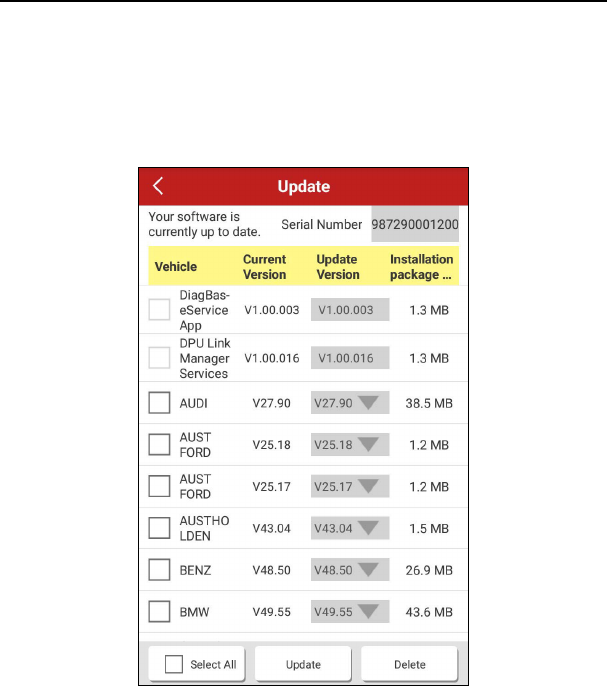
LAUNCH English User Manual
34
8 Software Update
Once a newer diagnostic software version is detected, a prompt message will
pop up on the screen. To keep synchronized with the latest version, tap “Update
now” to enter the update center.
Fig. 8-1
Tap “Update” to start downloading. Once downloading is finished, the software
packages will be installed automatically.
To delete the older version saved on the local storage, select the check box and
then tap “Delete”. Once it is successfully removed, the vehicle logo on the
diagnostic main menu will disappear at the same time.
Note: Before update, please make sure V1M has a strong Wi-Fi connection.

LAUNCH English User Manual
35
9 Personal Center
This function allows users to manage the VCI connector and diagnostic reports,
and personal information.
9.1 My report
This option is used to view the diagnostic report generated in process of vehicle
diagnosis. Additionally, delete, share operations are also supported.
Tap “My Report”, there are total 3 options available.
If user records the running parameters while reading data stream, it will be
saved as .x431 file and appear under Record tab.
In case the DTC result is saved on Read Trouble Code page, the files will be
listed under Report tab.
Fig. 9-1
9.2 My connector
This option is used to manage all your activated connectors.
If several VCI connectors are activated on this tool, a list of connectors will be
displayed on the screen. Once you choose the connector that belongs to other
account, you have to log out, and then input the right account to continue.
9.3 Activate connector
If the VCI connector has not been activated during the product registration, or if
you have lost the bound connector and bought another brand-new one, please
use this option to activate it.
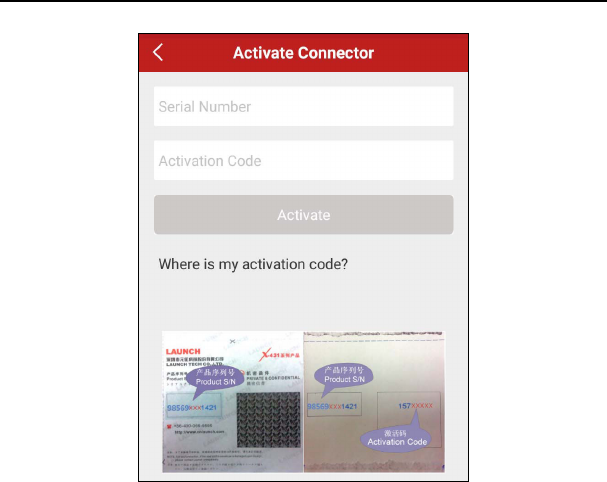
LAUNCH English User Manual
36
Fig. 9-2
Input the Serial Number and Activation Code, and then tap “Activate” to activate
it.
Note: The Serial Number and Activation Code can be found from the password
envelope.
9.4 Firmware Fix
Use this item to upgrade and fix diagnostic firmware. During fixing, please do not
cut power or switch to other interfaces.
9.5 Profile
Use this item to view and configure personal information.
9.6 Change password
This item allows you to modify your login password.

LAUNCH English User Manual
37
9.7 Settings
This function allows users to manage your personal information, configure
system settings and feedback your vehicle issues or diagnostic reports to us for
analysis.
9.7.1 Units of Measurement
It is designed to set the measurement unit. Metric System and English System
are available.
9.7.2 About
The software version information and disclaimer are included.
9.7.3 Log out
This option allows you to logout the system.
To logout the current user ID, tap “Exit from current account”.
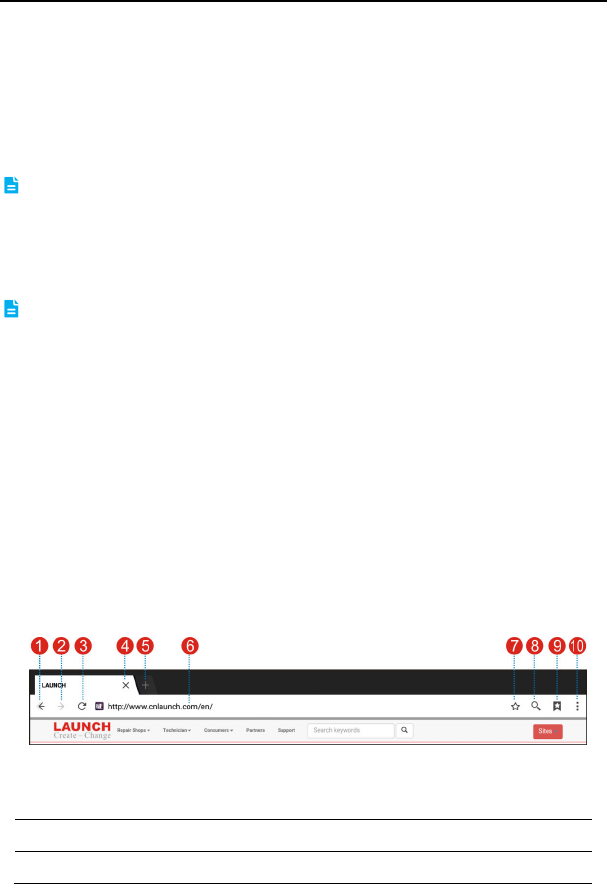
LAUNCH English User Manual
38
10 Others
10.1 Email
The function allows you to send and receive emails.
10.1.1 Configure an email account
Note: Before sending or receiving email, you have to set up an email account. In
addition, this function requires a stable network connection.
1. On the home screen, tap Email.
2. Choose the desired email account type.
3. Input email address and password, tap “Next”.
Note: If “Manual setup” is selected, please consult your email service provider for
detailed parameter setting.
4. Follow the on-screen instructions to proceed until the system prompts you
that the account setup has been finished.
10.1.2 Add an email account
1. Tap Settings -> Accounts.
2. Tap Add account.
3. Choose the desired account type.
10.2 Browser
10.2.1 Open browser
On the home screen, tap Browser to launch the browser. You can choose the
desired homepage or input the website address to browse.
Fig. 10-1
1 Return to the previous page.
2 Advance to the recently visited page.
3 Refresh the current page.

LAUNCH English User Manual
39
4 Close the current page.
5 Create a new tab.
6 Input a web address.
7 Add the current page as bookmark.
8 Open search bar.
9 Open bookmark list.
10 View more options.
10.2.2 Download files
Files, pictures, and applications can be downloaded from the website in browser.
For example:
Tap and hold a picture, then choose “Save image” from pop-up menu to
download it.
To download a link, tap and hold it, and then choose “Save link”.
To protect your V1M and personal data, please download
applications from trusted sources. To configure it, tap Settings -> Security, and
then slide the Unknown sources switch to off.
10.3 Synchronization
You can transfer media files and APK between the PC and V1M.
10.3.1 Connect to PC
1. Use the USB cable to connect the V1M to your PC.
2. Swipe from the top, a message “Connected as a media device” appears.
10.3.2 Run on PC
Perform the following steps:
y Locate the new disc.
y Copy the files.
10.3.3 Install an application
Do the following steps:
1. Tap Settings -> Security, and set the “Unknown sources” to ON, which
allows you to install apps from unknown sources.
2. A dialog box appears on the screen, tap “OK” to confirm.

LAUNCH English User Manual
40
3. Set the tool as “Connected as a media device”, and copy the APK file from
the PC to the tool.
10.4 Clear Cache
Doing so clears all browsing records and accounts and enables V1M
to run smoothly and quickly.
1. Tap Settings -> Apps.
2. Tap and select “Sort by size” to arrange all applications in size order.
3. Tap certain application, then tap “Clear Cache” to release the space these
cache files are occupied.

LAUNCH English User Manual
41
11 FAQ
1. How to save power?
¾ Please turn off the screen while V1M keeps idle.
¾ Set a shorter standby time.
¾ Decrease the brightness of the screen.
¾ If WLAN connection is not required, please turn it off.
¾ Disable GPS function if GPS service is not in use.
2. What should I do in case I forgot the screen lock?
You can set screen lock as pattern or password. If you forgot the password,
please consult your device provider or reset your device.
Warning: Resetting may cause data loss. Before use, please make sure important
data has been backed up.
3. How to do if the system runs slow?
In this case, please do the followings:
> Check all running applications and stop the unnecessary applications (Steps:
Settings -> Apps -> Running -> Tap the desired application and then tap “Stop”).
> Check all installed applications, remove the unnecessary applications (Steps:
Settings -> Apps -> Downloaded -> Tap the desired application and then tap
“Uninstall”).
If all steps mentioned above are finished and the system still works slowly.
Please try to close the system and reboot your V1M.
4. How to reset V1M?
Resetting may cause data loss. Before doing so, please make sure important data
and information has been backed up.
Do the following to reset V1M:
1. Tap “Settings” --> “Back & Reset”;
2. Tap “Factory data reset”;
3. Tap “Reset tablet”;
4. Tap “Clear all data” to start resetting until the tool automatically reboots.

LAUNCH English User Manual
42
Warranty
THIS WARRANTY IS EXPRESSLY LIMITED TO PERSONS WHO PURCHASE
LAUNCH PRODUCTS FOR PURPOSES OF RESALE OR USE IN THE
ORDINARY COURSE OF THE BUYER’S BUSINESS.
LAUNCH electronic product is warranted against defects in materials and
workmanship for one year from date of delivery to the user.
This warranty does not cover any part that has been abused, altered, used for a
purpose other than for which it was intended, or used in a manner inconsistent
with instructions regarding use. The exclusive remedy for any automotive meter
found to be defective is repair or replacement, and LAUNCH shall not be liable
for any consequential or incidental damages.
Final determination of defects shall be made by LAUNCH in accordance with
procedures established by LAUNCH. No agent, employee, or representative of
LAUNCH has any authority to bind LAUNCH to any affirmation, representation,
or warranty concerning LAUNCH automotive meters, except as stated herein.
Disclaimer
The above warranty is in lieu of any other warranty, expressed or implied,
including any warranty of merchantability or fitness for a particular purpose.
Purchase Order
Replaceable and optional parts can be ordered directly from your LAUNCH
authorized tool supplier. Your order should include the following information:
Order quantity
Part number
Part name
Customer Service
Any question during the operation, please call 86-755-84528722.
If your unit requires repair service, return it to the manufacturer with a copy of
the sales receipt and a note describing the problem. If the unit is determined to
be in warranty, it will be repaired or replaced at no charge. If the unit is
determined to be out of warranty, it will be repaired for a nominal service charge
plus return freight. Send the unit pre-paid to:
Attn: Customer Service Department Launch Tech Co., Ltd.
Launch Industrial Park,
North of Wuhe Avenue,

LAUNCH English User Manual
43
Banxuegang, Bantian,
Longgang, Shenzhen, Guangdong
P.R.China, 518129
Launch website: http://www. cnlaunch.com
http://www.x431.com
http://www.dbscar.com
Statement:
LAUNCH reserves the rights to make any change to product designs and
specifications without notice. The actual object may differ a little from the
descriptions in the manual in physical appearance, color and configuration. We
have tried our best to make the descriptions and illustrations in the manual as
accurate as possible, and defects are inevitable, if you have any question,
please contact local dealer or after-sale service center of LAUNCH, LAUNCH
does not bear any responsibility arising from misunderstandings.
NOTE: This equipment has been tested and found to comply with the limits for a
Class B digital device, pursuant to part 15 of the FCC Rules. These limits are
designed to provide reasonable protection against harmful interference in a
residential installation. This equipment generates uses and can radiate radio
frequency energy and, if not installed and used in accordance with the instructions,
may cause harmful interference to radio communications. However, there is no
guarantee that interference will not occur in a particular installation. If this
equipment does cause harmful interference to radio or television reception, which
can be determined by turning the equipment off and on, the user is encouraged to
try to correct the interference by one or more of the following measures:
- Reorient or relocate the receiving antenna.
- Increase the separation between the equipment and receiver.
-Connect the equipment into an outlet on a circuit different from that to which the
receiver is connected.
-Consult the dealer or an experienced radio/TV technician for help
Changes or modifications not expressly approved by the party responsible for compliance
could void the user's authority to operate the equipment.
This device complies with Part 15 of the FCC Rules. Operation is subject to the following two conditions:
(1) this device may not cause harmful interference, and
(2) this device must accept any interference received, including interference that may
cause undesired operation.